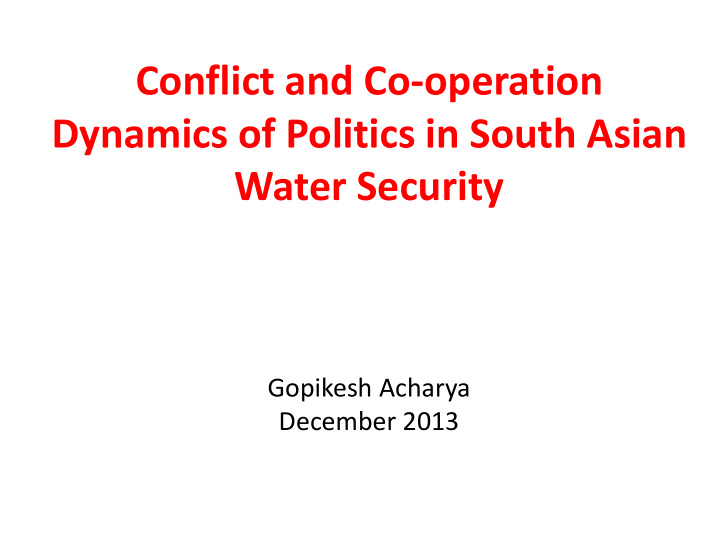



Conflict and Co-operation Dynamics of Politics in South Asian Water Security Gopikesh Acharya December 2013
Distribution of World’s Water Total water in the world (earth and ocean) Total water available on land Total water available in/on earth In the River 3% Glaciers Ice Caps Underground Water In the Lakes 0.3% 2% On Land In the Swamp 11% 30.7% 97% 69% In Ocean 87 % On Earth Source: Author's adaptation from Gleick 1996, pp.817-823, and Seckler et al. 1998, p.03.
Map of South Asia and Major Rivers Source: Google Earth
Findings of the Research • Nine of the major ten rivers in South Asia originate from China-controlled Tibet and China is reluctant to bi-lateral or regional agreements with downstream countries. • The SAn Countries are guided by hardliner national political interest, which has been problematic for regional cooperation. • India had a ‘Hydro - hegemonic’ status in 1950-60, now the situation has been quite changed. India, recently, is adopting ‘wait and watch’ policy. • The small neighboring countries of India are becoming more demanding of their rights. So regional cooperation is viable if each country came with true spirit.
Current Challenges of Water Security in South Asian Water 1. Rapid population growth and urbanization (increased demand of freshwater) 2. Shifting agricultural priorities 3. Growing public health challenges 4. Increasing use of energy 5. Inadequate cooperation on scientific research to comprehend water security effects 6. Weak state capacity (lack of human resource and financial footing) (In weak state- Government/citizen partnerships is needed) 7. Competition for markets for water supply services (lack of priority on environment) 8. Lack of preparedness to tackle with the impacts of global climate change and increasing pestilence and disease etc. 9. Reluctance towards transparency and sharing information 10. Contending national interests, political disagreements and fragile regional organizations 11. China having no water-sharing agreements with downstream countries 12. Insufficient domestic policy responses 13. Extending service to the un-served and maintaining quality of the service to partially served
Ways to Sustainable Regional Co-operation for Water Security 1. Sharing data related to hydrology and planned projects on the shared rivers 2. Documentation of the past agreements and readdressing them in need 3. Domestic effort to manage water first then national efforts for inclusive regional cooperation – prioritize water sector development under a national department because everything kept in priority means nothing is kept in priority 4. All water is local, but all trans-boundary water is not local (one size will not fit all) 5. Donor Agencies need to extend integrated policy/technology assistance for SWM 6. The country which is able of taping its water resource should share knowledge to another which is unable to tap its resource 7. Each country in the region needs to come to reasonable compromises (Benefits to be shared mutually) 8. Managing water sectors not by the politicians but by the professionals (After agreements are politically ratified) 9. Environment-friendly management 10. Suitable criteria on water quality/allocation in shared programmes
Way Forward: Policy Options • Requirement of all-inclusive regional frameworks for cooperation • It is important to build up national political leadership/interest through evidence- based backing • Wider regional approach needs to be prepared in terms of regional priorities for trans-boundary water • Governments-citizen-donor agencies partnerships to support investment • Implement policy recommendations of evidence-based research and Implement the lessons learned • Adopt regional cooperation for improved water governance
Conclusion SAn countries have a common agrarian and socio-cultural status revolving around trans- boundary water. The population is growing and there is increased demand of water . Cooperation for water security in the region has been an important thing, while creating an environment for regional cooperation has been a real challenge . The study has shown some findings which say that regional cooperation is possible in SA for overall water security in the region. Most of the riparian pairs have already been involved in a kind of bi-lateral agreements , some of which are not turned to be effective and some are really effective . But, the overall scenario suggests SA is in a greater need of regional cooperation for water security in the region, which is possible if countries came with true sprit, without hard-liner political interests, and with active engagement of professionals (not only politicians).
References Gleick, PH 1996, Water Resources , In Schneider SH, Encyclopedia of Climate and Weather, New York: Oxford University Press, pp.817-823. Seckler D, Upali A, Molden D, Silva de R, & Barker R 1998, World water demand and supply, 1990 to 2025: Scenarios and issues , Research Re-port 19, Colombo: International Water Management Institute, p.03. -The End-
Recommend
More recommend